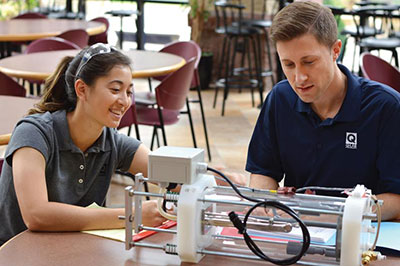October 20, 2018 04:00 AM
Read the original article on
Crain's Cleveland Business website.

When Doug Grossman took over running Q-Lab Corporation for his father in 1985, the company had 20 employees. Today, the Westlake-headquartered firm —which manufactures scientific chambers that simulate the damaging effects of sunlight, rain and corrosion, so that chemists and engineers can decide what materials to use for products — has about 250 employees who serve 5,000 customers in 60 countries.
Grossman attributes Q-Lab’s growth and success first and foremost to treating customers fairly. “We never upsell,” he says. “We never try to sell the customer the most expensive product we’ve got; we always try to sell them the product that’s right for them.” But at all levels, the organization strives for innovation, particularly with an eye toward becoming more efficient.
That’s evident in changes Q-Lab’s made to its order desk in recent years. “Some of (these changes involve) automation, but a lot of them are just changing the process and how things are handled, so that we can process our customers’ orders faster and more accurately,” Grossman says. “Those incremental improvements and innovations are really what drives the profits of the company.”
Incremental changes that lead, over time, to major improvements in manufacturers are often implemented through programs of continuous improvement that follow the concept of lean manufacturing, where employees are empowered to find those ways to make their workplace more efficient every day. “Many, if not most, manufacturers deploy lean as a tool, but there is always room to improve or reignite stagnant lean programs,” says MAGNET vice president of operations Mike O’Donnell.
In the coming years, being more productive while exerting less effort — which is the ideal of lean manufacturing as well as the application of new technologies such as automation, robotics, 3D printing, and Internet of Things — is going to be a must for every manufacturer, big and small. “We make more in Northeast Ohio than we did even 25 years ago — and we do it with far fewer people,” explains MAGNET CEO and president Ethan Karp.
The shrinking labor pool facing manufacturers is due both to an abundance of workers reaching retirement age and a shortage of employees with the ability to use cutting-edge manufacturing technology. Yet today’s manufacturing employees are incentivized to learn new skills and technologies. “There are fewer workers and increasing amounts of GDP being generated, so companies are able to pay employees much higher wages,” O’Donnell says. Such is good news for the industry as a whole, he enthuses: “This is a great time for manufacturing. This is the career to get into today for a lifetime of growth and excitement.”
Q-Lab is proof of how embracing innovation works. In fact, Grossman says his company pays higher wages than other companies in their industry space. “Everybody at Q-Lab knows that if the company’s processes are more efficient, we’re better able to compete,” he explains. “In all of our departments, I can see we get more done with less effort now than we did three years ago, five years ago, 10 years ago.”
MAGNET can help manufacturers think through the ROI of automation, robotics, refreshing lean programs that are not as effective today as they once were (or starting new lean programs), and many other efficiency-driving innovations. MAGNET’s Power Assessment is one way we support manufacturers with an immediate impact. Learn more about MAGNET’s Power Assessment at www.manufacturingsuccess.org/power-assessment-career, or call Linda Barita at (216) 391-7766.
Read the original article on
Crain's Cleveland Business website.